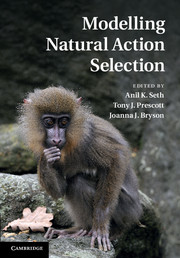Book contents
- Frontmatter
- Contents
- Foreword
- Preface
- Contributors
- 1 General introduction
- Part I Rational and optimal decision making
- 2 Introduction to Part I: rational and optimal decision making
- 3 Do we expect natural selection to produce rational behaviour?
- 4 Optimised agent-based modelling of action selection
- 5 Compromise strategies for action selection
- 6 Extending a biologically inspired model of choice: multi-alternatives, nonlinearity, and value-based multidimensional choice
- 7 Bayesian approaches to modelling action selection
- 8 Post-retrieval inhibition in sequential memory search1
- Part II Computational neuroscience models
- Part III Action selection in social contexts
- Index
- Plate section
- References
5 - Compromise strategies for action selection
from Part I - Rational and optimal decision making
Published online by Cambridge University Press: 05 November 2011
- Frontmatter
- Contents
- Foreword
- Preface
- Contributors
- 1 General introduction
- Part I Rational and optimal decision making
- 2 Introduction to Part I: rational and optimal decision making
- 3 Do we expect natural selection to produce rational behaviour?
- 4 Optimised agent-based modelling of action selection
- 5 Compromise strategies for action selection
- 6 Extending a biologically inspired model of choice: multi-alternatives, nonlinearity, and value-based multidimensional choice
- 7 Bayesian approaches to modelling action selection
- 8 Post-retrieval inhibition in sequential memory search1
- Part II Computational neuroscience models
- Part III Action selection in social contexts
- Index
- Plate section
- References
Summary
Summary
Among many properties suggested for action selection mechanisms, a prominent one is the ability to select compromise actions, i.e., actions that are not the best to satisfy any active goal in isolation, but rather compromise between the multiple goals. This chapter briefly reviews the history of compromise behaviour and performs experimental analyses of it in an attempt to determine how much compromise behaviour aids an agent. It concludes that optimal compromise behaviour has a surprisingly small benefit over non-compromise behaviour in the experiments performed, it presents some reasons why this may be true, and hypothesises cases where compromise behaviour is truly useful. In particular, it hypothesises that a crucial factor is the level at which an action is taken (low level actions are specific, such as ‘move left leg’; high level actions are vague, such as ‘forage for food’). The chapter hypothesises that compromise behaviour is more beneficial for high-level actions than low-level actions.
Introduction
Agents act. An agent, be it a robot, animal, or piece of software, must repeatedly select actions from a set of candidates. A controller is the mechanism within an agent that selects the action. The question of how to design controllers for such agents is the action selection problem. Researchers who consider the action selection problem have identified potential properties of these controllers. One such property is the ability to exhibit compromise behaviour. A controller exhibits compromise behaviour when the agent has multiple conflicting goals, yet the action selected is not the optimal action for achieving any single one of those goals, but is good for achieving several of those goals in conjunction. For example, a predator stalking two prey might not move directly toward one of the prey, but in between the two, in case one flees (Hutchinson, 1999). The action would not be optimal for individual goals to catch either prey, instead being a compromise between them.
- Type
- Chapter
- Information
- Modelling Natural Action Selection , pp. 61 - 90Publisher: Cambridge University PressPrint publication year: 2011



